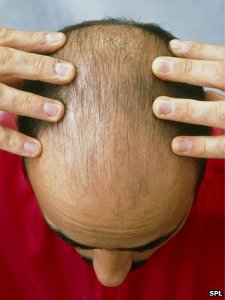What are the chances that I will go bald? How bald will I be? Can I know for sure? These are among the most common questions we get from patients in our hair loss consultations. Despite extensive knowledge about the mechanisms and causes of androgenetic alopecia (common baldness), the answers to these questions have been a bit hazy. New research has sharpened the focus on the genetic mix that results in hair loss and has enabled more accurate predictions. A study published in February 2017 in the journal PLoS Genetics identified over 250 gene locations newly linked to hair loss. Using this information, researchers more accurately predicted severe balding compared to previous methods.
Background
We know that susceptibility to hair loss is driven by genetics. One in two men in their 50s experience some degree of balding, with that proportion increasing to over 60% of men aged 60 and over. We also know that one of the most important genes in hair loss, called the androgen receptor (AR) gene, is located on the X chromosome. Outside of that, knowledge of the precise genetic makeup resulting in baldness is sparse and there is wide variation in balding patterns. Some genetic tests, such as the HairDx test, have been developed to predict a patient’s risk of balding, but lack the ability to determine its severity. To date, the best method for predicting the extent of future hair loss is to have an experienced physician take a personal and family history and perform a physical examination that includes an assessment of miniaturization of scalp hair.
Developing a more thorough understanding of the complex genetic relationships that result in hair loss will be important in clinical practice as these relationships may help predict future hair loss and guide methods of treatment.
The Study
Researchers selected a pool of more than 52,000 men with male pattern baldness from UK Biobank. This is a massive database of over half a million people aged 40-69 years with information accumulated from 2006 to 2010. This pool was over four times the size of the previously largest hair loss study. Researchers applied a genome-wide association study (GWAS) to a cohort of about 40,000 men and identified 287 statistically important gene locations (loci) linked to varying degrees of baldness — more than 35 times the eight genetic signals found in the previous largest study.
Using this set of 247 loci on non-sex, or autosomal, chromosomes and 40 loci on the X chromosome, the researchers analyzed the remaining 12,000 men for predictive patterns. The results indicated that the predictive value of using this set of gene loci was 0.78 for severe hair loss, 0.68 for moderate hair loss, and 0.61 for slight hair loss. When the subject’s age was added, the predictive score improved to 0.79 for severe hair loss, 0.70 for moderate hair loss, and 0.61 for slight hair loss. Subjects whose individual scores, based on their genetic makeup, were below the mid-point of the range of scores were significantly more likely to have no hair loss than severe hair loss. By contrast, almost 60% of subjects whose individual scores were in the top 10% of the range of scores were moderate to severely bald.
While the predictions were not extraordinarily accurate – the authors characterized the accuracy as “still relatively crude” – they did show a distinct improvement in predictive accuracy over prior studies.
Summary
Hair loss is a serious concern for many people. Research shows that men with extensive hair loss may experience significant psychosocial impacts such as reduced self-image and reduced social interactions. Some studies have associated baldness with increased risk of prostate cancer and heart disease.
Understanding the complex factors that comprise the genetics of hair loss can help physicians potentially customize treatments based on a patient’s genetic profile and their risk of balding. Beyond that, diagnosing the potential severity of hair loss may help doctors get a head start on treating what could be related life-threatening conditions.
With large databases like UK Biobank, researchers can now drill down into this information and develop increasingly clear, highly granular data sets that can identify complex systems and potentially lead to improved treatments.
References
Hagenaars SP, Hill WD, Harris SE, Ritchie SJ, Davies G, Liewald DC, et al. (2017) Genetic prediction of male pattern baldness. PLoS Genet 13(2): e1006594. doi:10.1371/journal.pgen.1006594
Posted by





